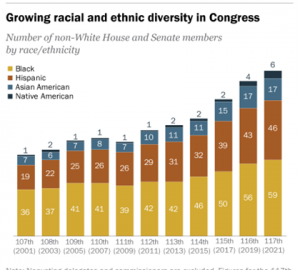Diversity on the rise in US politics
US representative politics is seeing more race, religious and gender diversity while Australia’s political system remains stubbornly male and white, according to a new study.
Despite the xenophobic policies or former president Donald Trump and the widespread voter suppression of minorities, about a quarter of voting members, or 23 per cent, of the US House of Representatives and Senate are from racial or ethnic minorities.
 This makes the 117th Congress the most racially and ethnically diverse in US history, according to the Washington-based think tank the Pew Research Center.
This makes the 117th Congress the most racially and ethnically diverse in US history, according to the Washington-based think tank the Pew Research Center.
The study found that increased diversity has been a long-running trend toward higher numbers of non-White lawmakers in Washington.
By comparison just 14 of the 151 Australian federal MPs, or less than 10 per cent, are from non-European or indigenous backgrounds.
The Pew Center found the new US Congress is the sixth to break a diversity record set by the one before it.
“Overall, 124 lawmakers today identify as Black, Hispanic, Asian/Pacific Islander or Native American,” the Pew Center report said.
“This represents a 97 per cent increase over the 107th Congress of 2001-03, which had 63 minority members,” it said.
 “Among today’s senators and representatives, the overwhelming majority of racial and ethnic minority members are Democrats (83 per cent), while 17 per cent are Republicans.
“Among today’s senators and representatives, the overwhelming majority of racial and ethnic minority members are Democrats (83 per cent), while 17 per cent are Republicans.
“This represents a shift from the last Congress, when just 10 per cent of non-White lawmakers were Republicans. Our analysis reflects the 532 voting members of Congress seated as of Jan. 26, 2021,” the report said.
It said that although recent Congresses have been increasingly diverse, they have still been disproportionately white when compared with the overall population of the US.
“Non-Hispanic White Americans account for 77 per cent of voting members in the new Congress, considerably larger than their 60 per cent share of the US populations overall,” the report said.
And the gap has not narrowed over time. In 1981, 94 per cent of members of Congress were White, compared with 80 per cent of the US population.
However, in the House of Representatives, representation of some racial and ethnic groups is now equivalent to their representation in total population, the report said.
Today 13 per cent of house members are Black, similar to the share of Black Americans in the general population.
And Native Americans now make up about 1 per cent of both the House and the overall US population.
But other racial are less represented in terms of their presence in the overall population.
“The share of Hispanics in the US population (19 per cent) is about twice as high as it is in the House (9 per cent). Asian Americans and Pacific Islanders together account for 6 per cent of the national population and 3 per cent of House members.
The report says that in the House, Republicans account for a larger share of newly elected minority representatives than in the past.
Of the 16 first-term representatives who are non-White, nine are Republicans, compared with just one of the 22 new representatives in the previous Congress but this number includes only two Black Republicans.
There are eleven senators are a racial or ethnic minority, up from nine in the previous Congress, the Pew report says.
Six senators are Hispanic, two are Asian and three are Black. First-term Senator Democrat Raphael Warnock is the first Black Senator from Georgia and fellow Democrat first-termer Alex Padilla, is the first Hispanic Senator to represent California, the Pew Center report said.
Senator Padilla took the place of new Vice President and former Senator. Kamala Harris, who was one of just four women of colour, and the only Black woman, serving in the Senate.
“Just three of the 11 non-White senators are Republicans: Tim Scott of South Carolina is Black, and Marco Rubio of Florida and Ted Cruz of Texas are both Hispanic,” the Pew report said.












